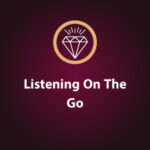It’s been over two years since the pandemic started, and for many of us, our daily lives have changed in ways we hardly imagined when this decade began. More and more of us are working from home these days, and we’re staying at home even when we aren’t working. We’re more isolated than we used to be, and dealing with a lot more stress and uncertainty. Finding time to take care of our mental health can be a challenge, but it’s just as important as ever – and sound has come to play a vital part in that effort, from guided meditation and affirmations to binaural beats and ASMR videos.
Two of the most popular and successful forms of sonic therapy are mindful meditation and positive affirmations, and they’ve both come a long way over just the past few years. Mindfulness is the art of being precisely in the moment, without worrying about the past or thinking about the future, or being distracted by anything at all. Completely clearing our thoughts can be tricky, and that’s where guided meditation, which uses sound and music to help lead the way, can help.
Studies have shown that the health benefits range from lowering stress and improving our mental well-being to bolstering the immune system and reducing inflammation. Although its roots are thousands of years old, the modern practice of mindful meditation has evolved into high-tech pods and meditation apps you can download for your smartwatch. Some of them can get a little pricey, but if you’re just starting out and want to give it a try, you can find a link to UCLA’s free Mindful app, and a separate list of guided meditation tracks that you can download, on my blog.
https://www.uclahealth.org/marc/mindful-meditations
Positive affirmations are another way to help change our mindset, to bolster our self-esteem and sense of optimism. Psychology and even MRI studies have found that they have a positive effect on our behavior and sense of wellness, although they also found that, for people with low self-esteem, affirmations in the future tense work better than the present. So if you find that starting a sentence with “I am” just doesn’t feel right, try saying “I will” instead. I’ve also included a YouTube link on my blog to a morning affirmation video presented by voice artist Prachi Chaube (Prah-chee Chau-bay).
Binaural beats are a much more recent discovery when it comes to audio therapy, one that’s still being researched. The idea behind them, though, is fascinating. If you take a pair of headphones and play a sound through them with a slightly different frequency for each ear, your brain blends them together into a new sound that’s the difference between them. So, for example, if the left earphone plays a 300-hertz tone and the right earphone plays a 280-hertz tone, we perceive it as a 20-hertz tone. That’s almost too low for us to hear, but our brains still process it, and different frequencies might resonate with our own neural oscillations to trigger different states of awareness.
Listening to that 20-hertz tone, for instance, could cause the brain to enter a beta wave pattern, which can help us feel more awake and alert. A lower binaural beat, such as a 2-hertz tone, might lead to a delta wave pattern, the deepest stage of sleep. Do binaural beats really work? The scientific verdict’s still out, but the good news is that studies have shown there’s no harm to listening to them, so long as you don’t turn the volume up too loud. If you want to try it out for yourself, I’ve included a video link on my blog. Just make sure you’re wearing headphones, or the effect won’t work.
One of the most recent developments in sound therapy and mental wellness is ASMR: it first emerged as an online phenomenon around 2007 and has become immensely popular since then, with over fifteen million YouTube videos as of last year. Short for “autonomous sensory meridian response,” a name given to it by ASMR proponent Jennifer Allen in 2010, it refers to both a pleasantly tingling sensation along the spine that certain soft, rustling sounds can trigger, and to online relaxation videos that aim to create that effect for the viewer with whispers, props, music, and other sounds.
Some psychologists think the sensation of ASMR might be a kind of synesthesia, with our minds experiencing certain sounds as touch, while MRI brain scans suggest it might even be connected to our grooming instincts. What started with hosts simply whispering to the viewer has grown into a whole online genre of videos featuring elaborate scripts, costumes, set designs, and even special effects. You can find links on my blog to a YouTube video by one of its most famous “ASMRtists,” Goodnight Moon, as she plays a shopkeeper selling the viewer a pet dragon, and to another one of my favorite artists, Moonlight Cottage, as she helps the viewer choose a magic wand. Even if you don’t end up experiencing the tingles, I think you’ll have a lot of fun with both of these videos.
Goodnight Moon: Dragon Egg Shopping at Maybell’s Menagerie (ASMR)
Moonlight Cottage ASMR: Wand Shop
From virtual classrooms and remote workplaces to Zoom calls with our friends and family, we’re spending more time online than ever before. Just as our days have become more virtual, though, so have our resources for managing stress and anxiety. And sound, whether it’s a meditation app that guides our breathing technique, a binaural beat that subtly rewires how we think, or a relaxing YouTube video about a whispery fantasy world, remains an essential part of nurturing our well-being.
Would you consider giving this podcast an honest review? You can do that here: https://lovethepodcast.com/audiobranding. And if you like what you hear (and read!) – please do share it with anyone you think might be interested. Thanks so much!
And if you’re interested in crafting an audio brand for your business, why not check out my FREE download – Top 5 Tips For Implementing An Intentional Audio Strategy at https://voiceoversandvocals.com/audio-branding-strategy/


